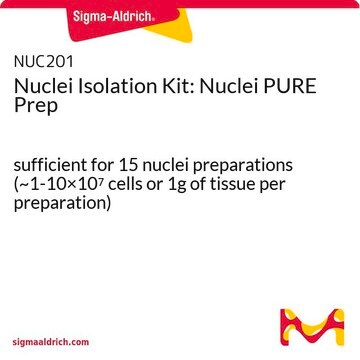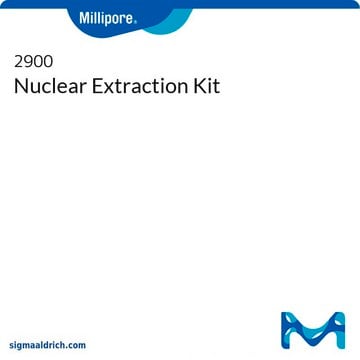NUC101
Nuclei Isolation Kit: Nuclei EZ Prep
sufficient for 25 nuclei preparations (~1-10×107 cells/preparation)
Synonym(s):
Rapid mammalian nuclei isolation kit
Sign Into View Organizational & Contract Pricing
All Photos(1)
About This Item
UNSPSC Code:
12352207
NACRES:
NA.32
Recommended Products
usage
sufficient for 25 nuclei preparations (~1-10×107 cells/preparation)
shelf life
1 yr at 2‑8 °C
packaging
pkg of 1 kit
application(s)
cell analysis
foreign activity
nuclease and protease, free
shipped in
wet ice
storage temp.
2-8°C
General description
The Nuclei EZ Prep Kit was developed for the rapid isolation of nuclei from mammalian cells. The kit provides a high yield of nuclei from commonly used cell types.
Application
Suitable as a source of nuclear components, to produce nuclei for in vitro apoptosis assays, and for functional studies.
Biochem/physiol Actions
The protocol provides a high yield of nuclei from commonly used mammalian cells, including both adherent (e.g., HEK293 and COS7) and non-adherent (e.g., Jurkat and HFN7.1) cell lines and peripheral blood mononuclear cells (PBMCs). The preparations are suitable for many cell biology applications, e.g., as a source of nuclear components such as chromatin, genomic DNA, histones and nuclear RNA/RNP, produces nuclei for in vitro apoptosis assays, and functional studies such as examination of the transcriptional status of cells.
Other Notes
All procedures should be carried out on ice or 2-8°C.
related product
Product No.
Description
Pricing
Storage Class Code
10 - Combustible liquids
Flash Point(F)
Not applicable
Flash Point(C)
Not applicable
Choose from one of the most recent versions:
Certificates of Analysis (COA)
Lot/Batch Number
Don't see the Right Version?
If you require a particular version, you can look up a specific certificate by the Lot or Batch number.
Already Own This Product?
Find documentation for the products that you have recently purchased in the Document Library.
Customers Also Viewed
Analysis of nuclear RNA, Chapter 14.
Robert E. Farrell, Jr., ed.
RNA Methodologies: A Laboratory Guide for Isolation and Characterization, 235-263 (1993)
Christina N Vallianatos et al.
Communications biology, 3(1), 278-278 (2020-06-03)
Histone H3 lysine 4 methylation (H3K4me) is extensively regulated by numerous writer and eraser enzymes in mammals. Nine H3K4me enzymes are associated with neurodevelopmental disorders to date, indicating their important roles in the brain. However, interplay among H3K4me enzymes during
Buqing Ye et al.
Nature communications, 8(1), 1518-1518 (2017-11-16)
Lymphoid lineage commitment is an important process in haematopoiesis, which forms the immune system to protect the host from pathogen invasion. However, how multipotent progenitors (MPP) switch into common lymphoid progenitors (CLP) or common myeloid progenitors (CMP) during this process
Yu-Yin Shih et al.
PloS one, 6(10), e26236-e26236 (2011-10-25)
Retinoic acid (RA) has been approved for the differentiation therapy of neuroblastoma (NB). Previous work revealed a correlation between glucose-regulated protein 75 (GRP75) and the RA-elicited neuronal differentiation of NB cells. The present study further demonstrated that GRP75 translocates into
Alan Selewa et al.
Scientific reports, 10(1), 1535-1535 (2020-02-01)
A comprehensive reference map of all cell types in the human body is necessary for improving our understanding of fundamental biological processes and in diagnosing and treating disease. High-throughput single-cell RNA sequencing techniques have emerged as powerful tools to identify
Our team of scientists has experience in all areas of research including Life Science, Material Science, Chemical Synthesis, Chromatography, Analytical and many others.
Contact Technical Service













